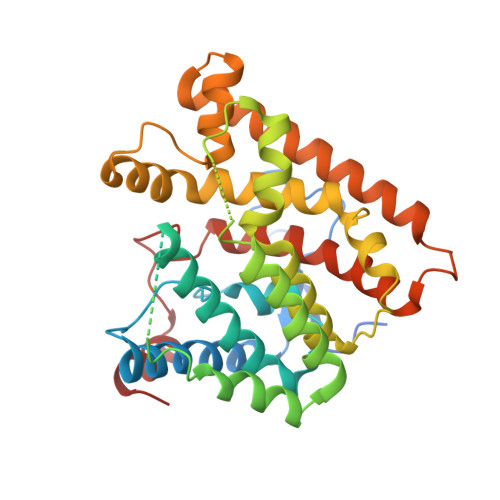Structure and Function of Fusicoccadiene Synthase, a Hexameric Bifunctional Diterpene Synthase.
Chen, M., Chou, W.K., Toyomasu, T., Cane, D.E., Christianson, D.W.(2016) ACS Chem Biol 11: 889-899
- PubMed: 26734760
- DOI: https://doi.org/10.1021/acschembio.5b00960
- Primary Citation of Related Structures:
5ER8, 5ERM, 5ERN, 5ERO - PubMed Abstract:
Fusicoccin A is a diterpene glucoside phytotoxin generated by the fungal pathogen Phomopsis amygdali that causes the plant disease constriction canker, first discovered in New Jersey peach orchards in the 1930s. Fusicoccin A is also an emerging new lead in cancer chemotherapy. The hydrocarbon precursor of fusicoccin A is the tricyclic diterpene fusicoccadiene, which is generated by a bifunctional terpenoid synthase. Here, we report X-ray crystal structures of the individual catalytic domains of fusicoccadiene synthase: the C-terminal domain is a chain elongation enzyme that generates geranylgeranyl diphosphate, and the N-terminal domain catalyzes the cyclization of geranylgeranyl diphosphate to form fusicoccadiene. Crystal structures of each domain complexed with bisphosphonate substrate analogues suggest that three metal ions and three positively charged amino acid side chains trigger substrate ionization in each active site. While in vitro incubations reveal that the cyclase domain can utilize farnesyl diphosphate and geranyl diphosphate as surrogate substrates, these shorter isoprenoid diphosphates are mainly converted into acyclic alcohol or hydrocarbon products. Gel filtration chromatography and analytical ultracentrifugation experiments indicate that full-length fusicoccadiene synthase adopts hexameric quaternary structure, and small-angle X-ray scattering data yield a well-defined molecular envelope illustrating a plausible model for hexamer assembly.
- Roy and Diana Vagelos Laboratories, Department of Chemistry, University of Pennsylvania , Philadelphia, Pennsylvania 19104-6323, United States.
Organizational Affiliation:



















